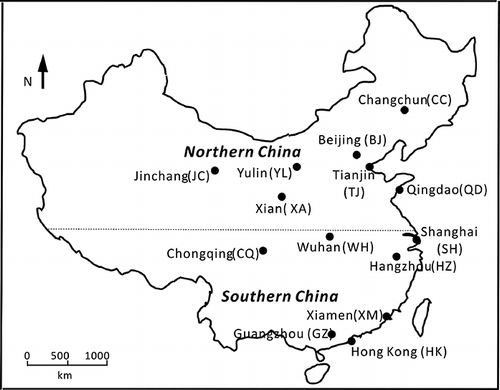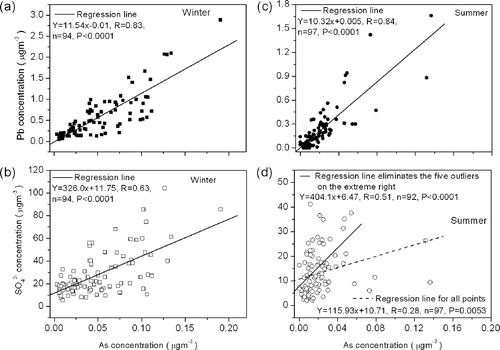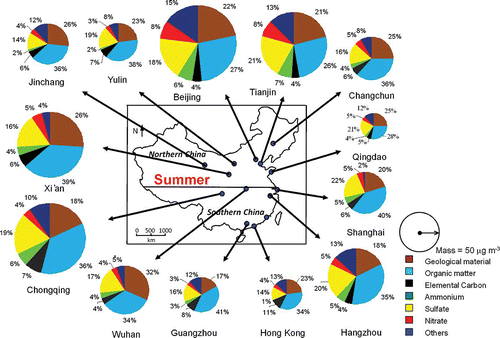Figures & data
Figure 1. PM2.5 samples were taken in seven southern China cities: Chongqing (CQ), Guangzhou (GZ), Hong Kong (HK), Hangzhou (HZ), Shanghai (SH), Wuhan (WH), and Xiamen (XM); and seven northern China cities: Beijing (BJ), Changchun (CC), Jinchang (JC), Qingdao (QD), Tianjin (TJ), Xi'an (XA), and Yulin (YL). Filter samples were obtained from 0900 to 0900 LST the next morning over 2-week periods during winter (January 6–20) and summer (June 3 –July 30) of 2003. Cities are classified as representing northern and southern China since: (1) precipitation events are more frequent and intense in southern China, and (2) northern China cities have lower wintertime temperatures, resulting in a greater amount of domestic heating, often using coal, along with shallower and more prolonged surface inversions at night and early morning.

Figure 2. Average (square), median (central horizontal bar), 25th and 75th percentiles (lower and upper bars), 1st and 99th percentiles (lower and upper x), and minimum and maximum (—) concentrations for each chemical component across all cities and seasons. Average chemical components are ordered by abundance, with OC (24.5 μg m−3), SO4 2− (19.9 μg m−3), NO3 − (9.9 μg m−3), NH4 + (9.2 μg m−3), EC (6.5 μg m−3), Cl− (3.1 μg m−3), K+ (1. 9 μg m−3), and Na+ (1.5 μg m−3) all being at important levels.

Table 1. Arithmetic averages ± standard deviations (μg m−3) for PM2.5 mass and chemical components by city and season. See for city codes. Each average contains ∼14 values
Table 2. Comparison of PM2.5 chemical component ratios for the 14 Chinese cities with ratios from selected cities in Europe, Canada, Mexico, and the United States
Figure 3. Relationships between PM2.5 As, Pb, and SO4 2− concentrations from the 14 cities during winter and summer, 2003.

Figure 4. Wintertime material balance of PM2.5 for the 14 Chinese cities. Organic matter (OM) is estimated as 1.6 × OC (CitationChen and Yu, 2007; CitationEl-Zanan et al., 2005; CitationEl-Zanan et al., 2009) to account for unmeasured hydrogen and oxygen. Geological material is estimated as 25 × Fe (CitationCao et al., 2008; CitationWu et al., 2011) to account for unmeasured oxygen and non-iron minerals. “Others” is the remaining unaccounted-for mass after subtracting the sum of measured components from the PM2.5 mass. Unaccounted-for mass can be potentially composed of unmeasured geological material (e.g., calcium carbonate), a higher fraction of oxygen in OM, and liquid water associated with NH4 +, NO3 −, and SO4 2− at the 35% to 45% relative humidity filter weighing conditions.

Figure 5. Summertime material balance of PM2.5 for the 14 Chinese cities. Organic matter, geological material, and others are explained in the caption.
